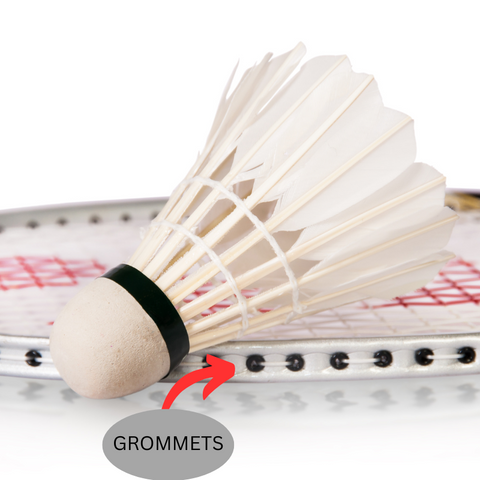Table of Contents
- Introduction
- 1. The Anatomy Of A Badminton Racket
- II. Choosing Your Badminton Racket
Introduction
Who doesn't love the adrenaline-fueled rush that a game of badminton brings? It's not just the thrill of smashing the shuttlecock across the net or the satisfaction of a perfectly timed shot. There's something more at its core - the badminton racket. This essential tool, often taken for granted, is what shapes your gameplay and helps you improve as a player. Let's dive into the fascinating world of the badminton racket, its intricacies, and how to choose the best one for you.
1. The Anatomy Of A Badminton Racket
Understanding your badminton racket is the first step in selecting the best equipment for your gameplay.The frame of a badminton racket comprises the head, the shaft, and the handle. In this section we will dive in-depth into the difference and benefits between these 3 key factors.

1.1. The Racket Head
-
The Head holds the strings of the racket. It can be either an oval or an isometric shape, each offering its distinct advantage in play. Let's dive into the differences between these two forms of badminton rackets.

1.1.1. Isometric Badminton Rackets
Isometric badminton rackets, also known as square-shaped rackets, have a broader, flatter head shape that offers a larger sweet spot. The sweet spot is the area of the badminton racket that generates maximum power when it strikes the shuttlecock.
-
Larger Sweet Spot: The primary advantage of an isometric badminton racket is its larger sweet spot. This makes the racket more forgiving, as shots that hit off-centre still retain a good amount of power and control.
-
Greater Consistency: The uniform structure of the isometric frame ensures a more consistent response across the string bed. This makes the player's shots more predictable and reliable, even when the shuttlecock isn't hit perfectly in the centre.
1.1.2. Oval Badminton Rackets
Oval badminton rackets, also known as conventional or traditional rackets, have a rounder, narrower head shape. These rackets have a smaller, centralised sweet spot.
-
Greater Power: If you hit the sweet spot, oval rackets can deliver a powerful shot, more so than their isometric counterparts. This can give players an edge in power play.
-
Enhanced Control: Experienced players often favour oval badminton rackets for their superior control. The narrow head shape allows for more precise shot placement, especially for players who consistently hit the sweet spot.
1.2. The Racket Shaft
When choosing a badminton racket, the shaft stiffness - whether it is stiff or flexible - plays a pivotal role in how the racket performs. In this section, we'll explore the differences between stiff and flexible badminton rackets.

1.2.1. Stiff Badminton Rackets
Stiff badminton rackets are less forgiving but offer more control. They require a well-honed technique to use effectively.
-
Superior Control: Stiff rackets offer excellent control as they allow players to direct their shots more accurately. The shuttlecock spends less time on the string bed, enabling more precise shot execution.
-
Fast Response: These rackets are better suited for advanced players with quick swing speeds. The stiff shaft allows for rapid response and suits an aggressive style of play.
1.2.2 Flexible Badminton Rackets
In contrast, flexible badminton rackets are more forgiving and tend to be easier for beginners to use effectively. They are designed for players with slower swing speeds.
-
Increased Power: A flexible badminton racket can help generate more power, particularly for players with slower swing speeds. The bending and snapping back of the shaft provide a whipping effect that can power shots even without a strong swing.
-
User-friendly: Due to their forgiving nature, flexible rackets are ideal for beginners and intermediate players still mastering their swing speed and technique.
1.3. The Racket Handle
When selecting a badminton racket, the size of the handle is a significant aspect to consider. This choice can greatly affect your comfort and performance during play. Let's discuss the differences between smaller and bigger handles in badminton rackets.
1.3.1. Smaller Handles in Badminton Rackets
Smaller handles in badminton rackets offer a different feel and cater to different styles of gameplay.Smaller sizes are usually denoted with G5 or G6.
-
Enhanced Maneuverability: Smaller handles allow for quick wrist action, making them excellent for deceptive shots, quick net play, and defensive blocks.
-
Better for Smaller Hands: If you have smaller hands, a racket with a smaller handle can provide a more comfortable and secure grip.
1.3.2. Bigger Handles in Badminton Rackets
On the other hand, larger handles bring different advantages to the court. They are usually denoted with a G3 or G4 grip size.
-
Stable Grips: Bigger handles tend to provide a more stable grip, which can be beneficial for powerful shots like smashes and clears. They can offer better control to direct your shots with precision.
-
Comfort for Larger Hands: Players with larger hands often find rackets with larger handles more comfortable and easier to grip firmly.
In summary, the choice between smaller and bigger handles in badminton rackets largely depends on your hand size, grip style, and the type of gameplay you prefer. It's always best to try out different handle sizes to see what feels most comfortable and enhances your performance on the court.
1.4. The Racket Material
The material of a badminton racket significantly affects its weight, durability, and performance.
-
Aluminium rackets are cost-effective, sturdy, and a good choice for occasional players.
-
Graphite rackets are lightweight, flexible, and deliver excellent power and control, making them a favourite among intermediate and professional players.
-
Carbon Fiber rackets are extremely light, strong, and provide exceptional manoeuvrability and speed.
Most rackets these days are generally full graphite frames and prices start from £35 onwards. Aluminum frames are normally priced below £20. If you are playing at least once a week than a graphite badminton racket will be the best choice for your game.
II. Choosing Your Badminton Racket
Now that you have clearer idea of the structure of a badminton racket lets jump to breaking down the key componets that will enhance your playing style. When selecting your badminton racket, it's essential to consider your skill level, style of play, and physical capabilities.
2.1 The Racket Weight
One of the crucial factors to consider when choosing a badminton racket is its weight. This can significantly influence your performance on the court. Here, we'll compare lighter and heavier badminton rackets, and their benefits.
Rackets are typically classified into four categories:
-
2U: 90-94g
-
3U: 85-89g
-
4U: 80-84g
-
5U: 75-79g
Heavy rackets (2U-3U) are suitable for players seeking powerful shots, while light rackets (4U-5U) offer excellent speed and control, ideal for defensive players. You can find the racket weight on the cone (Yonex,Victor) or shaft (Babolat) for the frame depending on the brand.

2.1.1 Lighter Badminton Rackets
Lighter badminton rackets typically weigh less than 85g and are often favored by players who prefer quick, reflexive play.
-
Quick Response: Lighter rackets offer faster swing speed and allow for rapid maneuvering. This makes them ideal for players who engage in fast-paced net play and defensive shots.

-
Less Strain: Due to their weight, these rackets are easier on the arm and wrist, reducing the risk of injuries. This makes them a great choice for beginners and younger players.
2.1.2 Heavier Badminton Rackets
Heavier badminton rackets, usually weighing more than 87g, offer their own
unique advantages, especially for power players.
-
Powerful Shots: The added weight provides additional power to your shots. This makes heavier rackets a favorite among players who rely on strong, aggressive strokes like smashes and clears.

-
Stability: Heavier rackets tend to offer better stability during shot-making, reducing the chances of the racket twisting in your hand upon impact with the shuttlecock.
2.2. The Balance Point
Before we dive into the impact on players, let's first comprehend what we mean by the 'balance point'. The balance point of a badminton racket is the point at which the racket balances horizontally while resting on a finger. It can be categorized into three types:
-
Head-Heavy Balance: The balance point is closer to the head of the racket.
-
Even Balance: The balance point is in the middle of the racket.
-
Head-Light Balance: The balance point is closer to the handle of the racket.

2.2.1. Head-Heavy Balance Rackets and Their Impact
Head-heavy rackets have their mass shifted towards the head, giving a power boost to the shuttle strike. They are perfect for aggressive players who revel in smashes and drives. The increased mass translates into higher momentum, resulting in powerful shots.
However, this type of racket requires a strong wrist and arm strength as it can be challenging to control and manoeuvre, especially during quick exchanges.
2.2.2. Even Balance Rackets: The Jack of All Trades
Even balance rackets strike a perfect equilibrium, offering a balance between power and control. These rackets cater to players with an all-round style of play. Whether you are smashing, driving, or defending, these rackets do a fair job at everything.
But, bear in mind, while they're decent all-rounders, they might not satisfy players looking for specialised performance in either power or speed.
2.2.3. Head-Light Balance Rackets: The Speed Demons
Head-light rackets have the mass towards the handle, making them light and easy to control. They are the best friend of players who prefer a defensive style and speedy net play.
Fast front-court exchanges, quick responses, and rapid racket manoeuvrability are the main advantages. However, they lack the weight needed for powerful smashes. Players preferring this type of racket might need to put in extra effort for power shots.
2.2.4. Understanding Your Game to Choose the Right Racket
Choosing the right racket is an art, but the balance point serves as a primary guiding factor. Are you an aggressive player seeking powerful smashes? Or do you enjoy quick, tactical plays at the net? Or perhaps you're a versatile player enjoying all corners of the court? Recognizing your playstyle is the first step towards choosing the perfect racket. Examples of some of the rackets chosen by the worlds best :
-
Lee Zii Jia - Victor Thruster Ryuga II Badminton Racket
Consider Lee Zii Jia, one of the world's premier singles badminton players, a true master of the game. His choice of weapon? The Victor Thruster Ryuga badminton racket, which possesses a markedly head-heavy balance. This isn't merely a random selection, but a tactical decision that perfectly complements his assertive playing style.
The head-heavy balance of this racket bolsters the power of each shot he makes, transforming them into fierce, game-changing strikes. So, if you're seeking to emulate the intensity and vigor of Lee's gameplay, the Victor Thruster Ryuga could be your ultimate game partner.
-
Arisa Higashino - Yonex Nanoflare 700 Badminton Racket
Imagine Arisa Higashino , a globally recognized front court maestro in badminton. Her weapon of choice is the head-light Yonex Nanoflare 700 badminton racket. This selection is far from arbitrary; it's a strategic move that empowers her to seize control of shots and rule the net with unparalleled dominance.
If you're seeking to emulate Arisa's swift interceptions and net mastery, the Yonex Nanoflare 700 could be your perfect court companion.
-
Aaron Chia - Yonex Arcsaber 11 Pro Badminton Racket
Meet Aaron Chia, a rising star in the world of badminton, renowned for his agility and precision. His chosen weapon on the court is none other than the Arcsaber 11 Pro, a selection that significantly enhances his gameplay. The Arcsaber 11 Pro, known for its even balance and superior control features, perfectly complements Aaroa's nimble footwork and precise shot-making skills. By using this racket, Aaroa is able to maximize his accuracy and responsiveness, turning every match into a thrilling display of athletic prowess.
III. Stringing Your Badminton Racket
Choosing the right strings and tension can drastically improve your badminton racket's performance.
3.1. Types of Strings
Badminton strings come in a variety of materials, thicknesses, and textures.
-
Natural Gut strings offer excellent feel and control, but are less durable and more expensive.
-
Nylon or Synthetic Gut strings are cost-effective, durable, and offer a good balance of power and control.
-
Multifilament strings offer excellent power and comfort, making them popular among recreational players.
3.2. String Tension
String tension refers to how tightly your racket's strings are pulled, measured in pounds (lbs). There are generally two categories: low tension (18-23lbs) and high tension (24-30lbs and above).

3.2.1. Low Tension (18-23lbs)
Low tension strings have more 'give', resulting in a trampoline effect that provides power. They are easier on the wrist and arm, making them suitable for beginners and players with a defensive playing style.
-
Enhanced Power: Low tension strings offer a significant power advantage due to the trampoline effect they generate. The greater 'give' or 'bounce' on the string bed propels the shuttlecock with more force, enabling players to hit harder and further with less effort.
-
Forgiving Sweet Spot: Rackets strung at a lower tension have a larger sweet spot - the area on the string bed that imparts maximum power and control to the shuttle. This can be particularly beneficial for beginners still working on their accuracy.
-
Reduced Strain on the Wrist and Arm: Low tension strings demand less physical strength, thus lowering the risk of arm and wrist injuries. They are gentler on the body, making them a good choice for younger players or those with existing injuries.
-
Increased Durability: Rackets with lower tension are more durable, as the strings are less strained and thus less prone to breakage. This can be a cost-effective choice for those who play often or are prone to breaking strings.
3.2.2. High Tension (24-30lbs and above)
High tension strings offer less bounce and more control over shots. These are suitable for aggressive players who generate their power and want better accuracy in their shot placement.
-
Superior Control: High tension strings offer excellent control over shot placement. The reduced 'bounce' means the shuttle stays on the string bed for a shorter time, allowing for precise shuttle control.
-
Solid Feel: Players often report a solid feel when the shuttlecock hits the string bed of high-tension rackets. This can improve the quality of shots, delivering a satisfying "thud" rather than a "ping" sound.
-
Advanced Gameplay: High tension strings are preferred by advanced players who generate their own power and require increased precision in their shots. The additional control helps in executing complex shots like tight net shots, drives, and deceptive shots.
-
Reduced Shuttle Speed: The shuttle speed off the racket is slower, allowing skilled players more time to prepare for the next shot, which can be a strategic advantage in fast-paced exchanges.
-
Smaller, More Defined Sweet Spot: Although the sweet spot is smaller in high tension rackets, it rewards players who consistently hit this spot with better control and precision, helping to refine their skill over time.
3.2.3. Choosing the Right String Tension for Your Game
Choosing the perfect string tension is all about understanding your playing style and physical condition.
-
For beginners or those who prefer power shots: Opt for low tension. It's easier to handle and offers more power.
-
For intermediate, advanced, or control-oriented players: High tension can give you better control and accuracy.
Keep in mind, the right tension for you may change as you evolve as a player and as your playing style and strength develop. If you are based in the North-West you can visit our local stores in Manchester and Liverpool and get your rackets strung.
IV. Maintaining Your Badminton Racket
Proper maintenance is crucial for the longevity and optimal performance of your badminton racket.
4.1. Regular Inspection and Cleaning
Inspect your badminton racket regularly for any cracks or string damage. Keep it clean using a dry cloth, and avoid using any harsh chemicals that could damage the racket's material.
4.2. Proper Storage
Store your badminton racket in a cool, dry place, preferably in a thermal bag to protect it from temperature changes.
4.3 Grommet Inspection
Badminton racket grommets, the small plastic tubes lining the string holes, play a critical role in protecting your racket's strings from potential frame damage.
 However, they can wear out over time and require replacement. Here are some situations when you should consider replacing your badminton grommets:
However, they can wear out over time and require replacement. Here are some situations when you should consider replacing your badminton grommets:-
Broken or Damaged Grommets: If you notice that a grommet is broken, cracked, or split, it's time for a replacement. Damaged grommets can cause the string to rub against the frame, which can lead to premature string breakage.
-
String Breakage: If your strings tend to break frequently at the same location, it may be due to a damaged grommet. An inspection will help you ascertain if the grommet at that particular spot needs to be replaced.
-
Wear and Tear: Over time, grommets can wear out and become less effective at protecting your strings. If your racket is old, it's a good idea to check the grommets for any signs of wear and tear.
-
Rough Edges: If you feel a sharp or rough edge when you run your finger along the grommets, it may be an indication that they need to be replaced. This could potentially damage your strings or affect your gameplay.
-
Misshapen Grommets: Grommets that are flattened or misshapen should be replaced as they may not adequately protect your strings.
In general, maintaining your badminton racket includes keeping an eye on the condition of your grommets. Regularly check them for signs of wear or damage, and replace them as needed to prolong the life of your racket and strings.






![Best Badminton Rackets For All Budgets 2024 – The Complete Guide.[Updated] - Smash Racket Pro](http://smashuk.co/cdn/shop/articles/best-badminton-rackets-for-all-budgets-2024-the-complete-guideupdated-678107_100x80_crop_center@2x.png?v=1744319751)